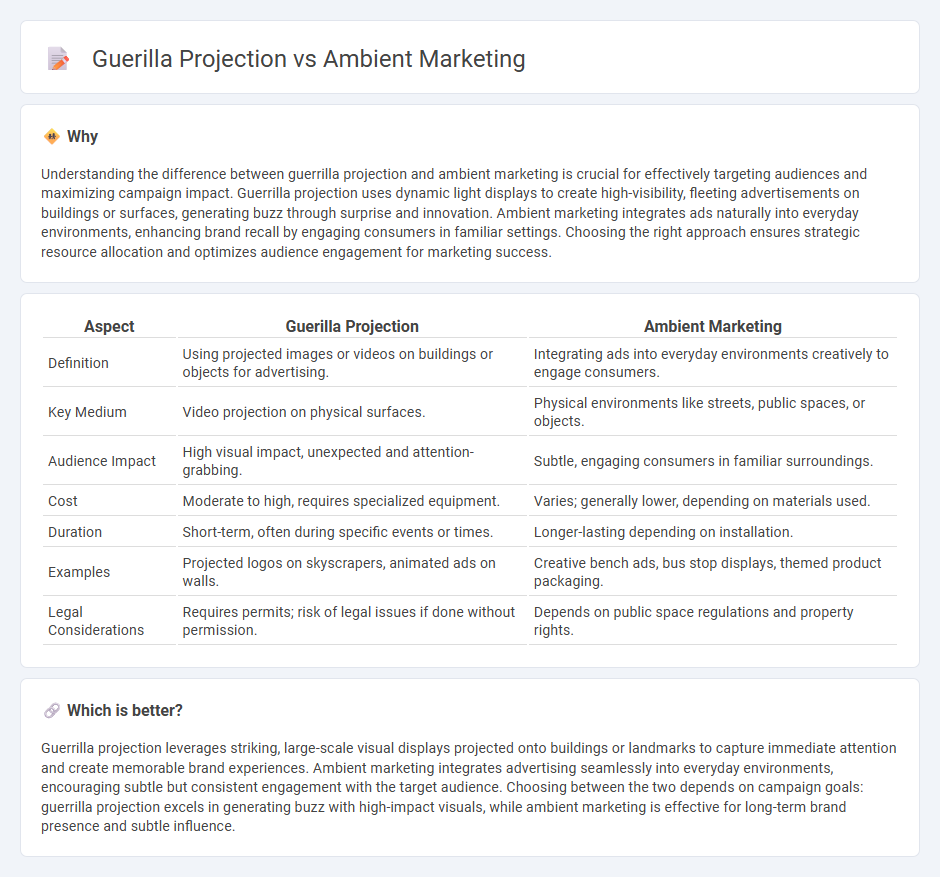
Guerrilla projection harnesses large-scale visuals projected onto buildings or urban surfaces to captivate audiences through unexpected, immersive experiences. Ambient marketing integrates brand messages into everyday environments, subtly influencing consumer behavior by transforming public spaces into interactive touchpoints. Explore how these innovative strategies redefine audience engagement and elevate brand visibility.
Why it is important
Understanding the difference between guerrilla projection and ambient marketing is crucial for effectively targeting audiences and maximizing campaign impact. Guerrilla projection uses dynamic light displays to create high-visibility, fleeting advertisements on buildings or surfaces, generating buzz through surprise and innovation. Ambient marketing integrates ads naturally into everyday environments, enhancing brand recall by engaging consumers in familiar settings. Choosing the right approach ensures strategic resource allocation and optimizes audience engagement for marketing success.
Comparison Table
| Aspect | Guerilla Projection | Ambient Marketing |
|---|---|---|
| Definition | Using projected images or videos on buildings or objects for advertising. | Integrating ads into everyday environments creatively to engage consumers. |
| Key Medium | Video projection on physical surfaces. | Physical environments like streets, public spaces, or objects. |
| Audience Impact | High visual impact, unexpected and attention-grabbing. | Subtle, engaging consumers in familiar surroundings. |
| Cost | Moderate to high, requires specialized equipment. | Varies; generally lower, depending on materials used. |
| Duration | Short-term, often during specific events or times. | Longer-lasting depending on installation. |
| Examples | Projected logos on skyscrapers, animated ads on walls. | Creative bench ads, bus stop displays, themed product packaging. |
| Legal Considerations | Requires permits; risk of legal issues if done without permission. | Depends on public space regulations and property rights. |
Which is better?
Guerrilla projection leverages striking, large-scale visual displays projected onto buildings or landmarks to capture immediate attention and create memorable brand experiences. Ambient marketing integrates advertising seamlessly into everyday environments, encouraging subtle but consistent engagement with the target audience. Choosing between the two depends on campaign goals: guerrilla projection excels in generating buzz with high-impact visuals, while ambient marketing is effective for long-term brand presence and subtle influence.
Connection
Guerrilla projection and ambient marketing both leverage unconventional public spaces to deliver high-impact visual messages that engage audiences in unexpected ways. These tactics focus on creating memorable brand experiences through innovative use of environments, increasing brand visibility without relying on traditional advertising channels. By integrating technology and creativity, they enhance consumer interaction and drive organic word-of-mouth promotion.
Key Terms
**Ambient Marketing:**
Ambient marketing integrates advertising seamlessly into everyday environments to engage consumers subtlety and creatively, often using unexpected placements for maximum impact. This approach enhances brand recall by making the marketing message part of the consumer's natural surroundings. Explore innovative ambient marketing strategies for deeper insights and practical applications.
Contextual Placement
Ambient marketing leverages strategically placed advertisements within everyday environments to engage consumers naturally, emphasizing relevance and immersion in specific contexts such as public transport or retail spaces. Guerrilla projection uses dynamic, often unexpected projections onto buildings or public areas to create impactful, memorable brand experiences that capture attention through novelty and creative spatial use. Explore how each method enhances brand visibility through contextual placement and transforms audience interaction.
Unconventional Locations
Ambient marketing leverages everyday environments such as public transportation, coffee shops, or office spaces to deliver brand messages seamlessly integrated into consumers' daily lives, enhancing engagement without interruption. Guerilla projection uniquely utilizes unconventional locations like building facades, alleyways, and urban landmarks to project dynamic visuals that captivate unexpected audiences through striking illumination and strategic positioning. Explore the innovative potential of these unconventional marketing tactics to elevate brand visibility and create memorable consumer experiences.
Source and External Links
What is Ambient Marketing: Advantages and Examples - Ambient marketing promotes products or services by placing creative ads in unusual locations, engaging consumers emotionally, and enhancing brand awareness through memorable, non-traditional campaigns.
Ambient Advertising: Strategies to Capture Consumer Attention - Ambient advertising places ads in everyday, unexpected places to increase visibility, engagement, and brand image using creativity and cost-effective methods that feel personal and non-intrusive.
Ambient Marketing - What Is It, Examples, Vs Guerilla ... - Ambient marketing is an unconventional technique that surprises audiences by placing advertisements in unexpected environments to create strong product awareness and memorable impressions.
 dowidth.com
dowidth.com